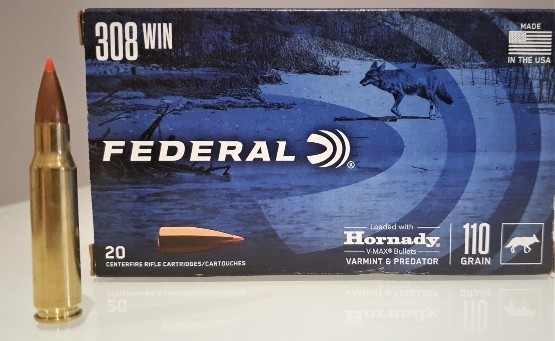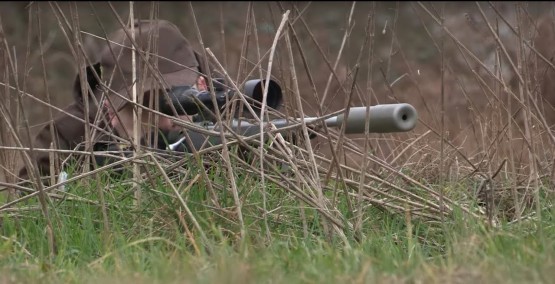Professional Hunter and Deer Stalker Peter S Jones considers if a 110 grain bullet in .308 calibre is appropriate for deer.

Regular readers will be aware of my admiration for the .308 calibre for deer stalking and until recently I have almost invariably used a 150 grain soft point Federal Power Shok bullet. The predictability of the performance of this combination in my Sako rifle has admittedly got me a bit stuck in a rut. That was until I spied the 110 grain Federal option loaded with Hornady V-Max bullets in my now local gun shop Wiltshire Rod & Gun.
Whilst I have frequently pointed out the great attribute of the .308 being its versatility and variety of grain weight, in honesty, I have rarely put the full range of bullet weights into practice.
In fact, the only exception, I have made to my 150 grain .308 combo, was my use of 180 grain bullets on some pretty big Boar in Romania. Yes, I have had plenty of clients use other heavy grain weights, but I have never gone lighter than 150 grains.
What caught my attention about the 110 grain was the bullet drop. With a 100 yard zero just 2.5 inches of drop at 200 yards and just 10 inches of drop at 300 yards. Compared with the 150 grain bullet which drops 3.9 inches and 14.7 inches respectively. That’s flatter than my .243 which, with 100 grains, which drops 3.3 inches and 12.4 inches and astonishingly is almost as flat as my .300 Win Mag which drops 2.5 inches and 9.6 inches respectively.

As for retained energy? Well, it’s no .300 Win Mag, but it certainly possesses a lot more punch than the .243 and gives up very little to the 150 grain bullet.
The 110 grain .308 bullet delivers 1659 ft-lbs at 200 yards and 1333 ft-lbs at 300 yards compared with the 150 grain which delivers 1702 ft-lbs and 1341 ft-lbs at the same distances. Of course, it’s not 300 Win Mag territory (the 300 still delivers equivalent energy at 500 yards) but If you’re looking for a flat shooting hard hitting round this my friends could be the answer!
So, its flat shooting but it is intended as a Varmint & Predator round. Is it therefore suitable for deer? Well having now shot a number of animals, including Roe and some pretty heavy Fallow Buck, I feel finally able to comment.
Federal refer to these bullets as a Varmint & Predator rounds and considering the ranges that many ‘Foxers’ operate at, the flat shooting nature of these bullets clearly have an application. However, my primary concern was that they may expand too fast on deer and lack the required penetration to exit.
My findings revealed this concern to be unfounded, with both Roe and Fallow up to 120lb larder weight, the bullet exited the chest cavity no problem. My observation of the terminal ballistics was a more destructive wound channel than the 150 grain, with increased tissue destruction and larger entry and exit wounds. In fact, I would go so far as to say, that the deer, perhaps due to the more devastating internal damage achieved to the internal organs, dropped after a shorter distance than with heavy grain weights.
I appreciate that this is not a scientific assessment, but for those that feel that the .308 traditionally suffers from a slightly too curved trajectory than other rivals such as the .243 or .270, they may feel that this presents a viable flatter shooting option. For those on a budget, it’s also substantially more affordable, at time of writing a box of 20 in the 110 grain were £22.95 versus the 150 grain which were £30.90.
A caveat, if you eat a lot of venison and are concerned about meat damage and lead contamination this may not be for you. I would estimate that along with a devastating wound channel comes greater lead contamination to the carcass, it certainly also results in more shock and tissue destruction to the surrounding area. But for the recreational stalker who is prepared to discard and cut tissue generously around the wound channel, it is a fabulous viable option.
A few other caveats - I am getting more cautious in my opinions as I get older! Remember, a general rule is that the heavier game you hunt, the heavier your bullet should be. This is simply because heavier bullets carry more energy. In a given calibre, they will also have longer ‘shanks’ which aid in maintaining momentum for greater penetration.
Another thing to consider is wind deflection. If bullets sport similar shapes and loads and are launched at maximum velocities, the heavier bullet will deflect less in crosswinds.
On the upside, for those that are recoil shy, you will appreciate the reduced recoil of a lighter bullet. Recoil is the cumulative results of muzzle velocity, powder weight and bullet weight. Put simply - heavier bullets kick more than light.
In my view, it is a primary requisite that all deer hunters and stalkers should have a sound knowledge of ballistics and make judgements based on the game they are hunting, the distances that they are shooting and the weather conditions in which they will likely be operating and select a bullet weight and calibres accordingly.
If you’d like to read about the history of ‘Expanding Ammunition’ follow this link: expanding-ammunition-for-deer
To read more about calibres follow this link to our calibres page: rifle-calibres
Or to find out more about what makes the .308 such an iconic calibre, simply follow this link: 308-winchester



















